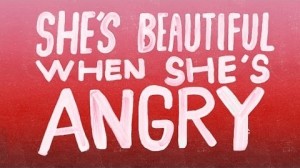Uppity Women Unite: She’s Beautiful When She’s Angry Film Review

In many ways, the documentary film She’s Beautiful When She’s Angry reaffirms the old proverb: “the more things change, the more they stay the same.” This documentary about the triumphs and pitfalls of the second-wave feminist movement in the United States begins with shots of a demonstration where women and men come together outside the Texas state capital to assert women’s rights to reproductive justice. Unfortunately, this protest did not take place in the 1960s but as recently as 2013.
Despite this ominous start, however, She’s Beautiful When She’s Angry presents an upbeat and energetic history of the women’s movement. It traces the movement’s roots in the New Left of the 1960s and the African-American civil rights movements through the formation of the National Organization for Women (NOW) and into the early 1970s with the Women’s Strike for Equality. In under two hours, the film manages to comprehensively cover the myriad ways in which second-wave feminism permeated all aspects of American culture and radically altered how we think about education, employment, parenthood, sexuality, reproductive rights, healthcare, and gender roles. By piecing together interviews with activists, original video footage from women’s liberation rallies, artwork and political cartoons by women, and dramatic readings of feminist essays and poems, the film creates a vibrant collage that reveals the revolution that that has allowed women to now work in previously male-dominated professions, pursue higher education, and control if and when they have children.
While the documentary acknowledges the sense of unity that many women experienced through consciousness-raising groups and protest marches, it does not shy away from depicting the divisions within the movement as well. Interviews with activists Fran Beal, Linda Burnham, and Roxanne Dunbar-Ortiz reveal the alienation that many women of color and low-income women felt when the movement prioritized the needs of white, middle-class women. “We were struggling to understand what was different about our perspective on women’s place in the world from what we were hearing from the mainstream women’s movement,” explains Burnham as she describes the creation of Black Sisters United. “And we couldn’t have that conversation in spaces that were majority white women.” The documentary also takes a hard look at Betty Friedan, founder of NOW and author of The Feminine Mystique, and her disdain for lesbian women, who she referred to as “the lavender menace.” Fortunately, thanks to agitating from activists such as Rita Mae Brown and Ellen Shumsky, the women’s movement came to address and even embrace lesbian concerns. “I called [NOW] on the carpet about lesbianism,” Brown asserts in an interview. “I said, ‘You are treating women the way men treat you. And those women are lesbians.” The individuals in the second wave didn’t always agree, but they did manage to come together to create powerful change. They were, as one protest button featured in the movie states, “uppity women uniting.”
The film celebrates these uppity women and their achievements, including increased legal protections for women such as Title IX and the outlawing of marital rape, but it also reiterates the need for women and men to defend the progress they’ve made and to continue the fight for equality. Forty years later, the gender pay gap still has not closed and women are all too often blamed when they report experiencing rape or sexual assault. While the U.S. Supreme Court’s decision on Roe v. Wade (1973) has not yet been overturned, state and local governments, at the urging of the fundamentalist religious right, have passed numerous laws to obstruct women’s access to abortions. Fortunately, the film affirms the work of the present generation of feminists and depicts feminist blogging and slut walks as young women’s continuation of the activism begun by their foremothers in the 1960s.
The humanist movement, in its insistence on the inherent worth of all human beings, regardless of gender, is closely aligned with the feminist movement. Both groups share concern over the erosion of women’s access to abortions and contraception and both have historically been critical of religion’s oppression of women. (In fact, Humanist Press will be releasing a book next week, Belief and Unbelief by Barbara G. Walker, on this topic.) The interconnectedness of feminism and humanism could perhaps be best summarized with a quote from She’s Beautiful When She’s Angry, spoken by a woman leading a protest: “What you see here is the beginning of a movement that women are human beings and that we have equal rights!”
Both humanists and feminists can learn much from this documentary both about how far we’ve come and about how much further we still have to go before women’s equality is achieved.
You can find a screening of She’s Beautiful When She’s Angry near you here.
